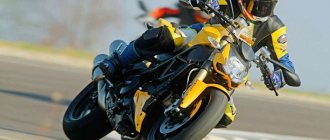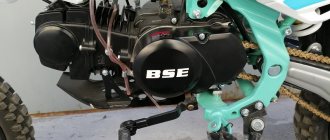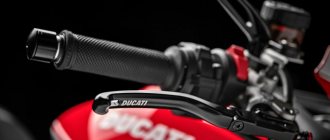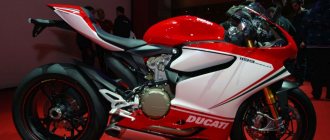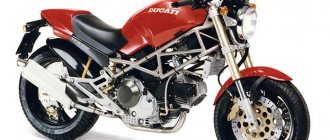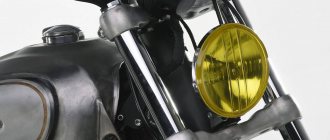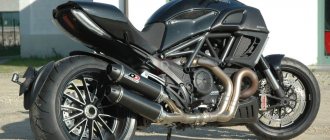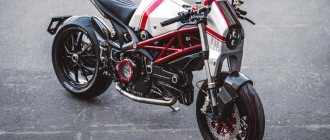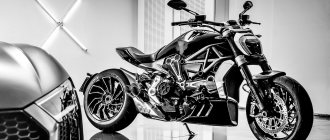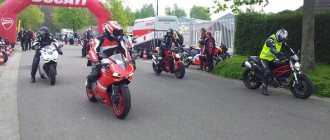REVIEW – DUCATI Streetfighter V4 – an angry street fighter with the heart of a sportbike
At the official presentation of the DUCATI World Première 2021, the long-awaited DUCATI Streetfighter V4 was presented, which was enthusiastically received by the public.
It's no secret that the basis of the new Streetfighter V4 was the DUCATI Panigale V4 sports bike, which lost its plastic and acquired some interesting features. These include new engine tuning, stunning design, the latest second-generation electronics package, redesigned stance, distinctive LED headlights and dual wings for improved aerodynamics. However, like the Panigale V4, the DUCATI Streetfighter V4 is an improved version of the V4S with some differences. Want to know more? Let's figure it out.
Design of DUCATI Streetfighter V4 2020
Speaking about the design of the DUCATI Streetfighter V4, one cannot ignore the fact that most of the motorcycle is a DUCATI Panigale V4 without fairings, but externally the bike looks like a real streetfighter - bold and uncompromising.
DUCATI Streetfighter V4 S
The tail of the Streetfighter V4 is indeed virtually identical to that of the Panigale V4, while the front features a very distinctive LED headlight reminiscent of the Joker's evil grin that inspired the designers when designing this bike.
DUCATI Streetfighter V4 headlight
Engine DUCATI Streetfighter V4
Unlike its sports ancestor, the DUCATI Streetfighter V4 proudly bares the 1,103 cc Desmosedici Stradale engine, which produces 208 horsepower at 12,750 rpm, which is only 6 horses lower than the DUCATI Panigale V4 sports model. however, this power did not disappear without a trace. According to DUCATI, the Streetfighter V4 has received a 30 percent increase in torque per 100 km/h compared to the Panigale. At the same time, the maximum torque is 123 Nm at 11,500 rpm, which is practically no different from the Panigale V4, and this is a definite plus for the predominantly urban use of the motorcycle.
The Desmosedici Stradale 90° V4 engine is the most powerful in the urban naked segment
Electrics DUCATI Streetfighter V4
To tame the beastly nature of the engine, DUCATI engineers have introduced an advanced 6D IMU electronics package based on a 6-axis inertial measurement system, which includes ABS Cornering EVO for safe lean braking during cornering without the need to straighten the bike, DUCATI Traction Control (DTC) EVO 2 to prevent the rear wheel from slipping during a sharp opening of the gas, DUCATI Slide Control (DSC) is a system that controls wheel slip in turns, DUCATI Wheelie Control (DWC) EVO to prevent wheelies, DUCATI Power Launch (DPL) allows you to move off with maximum acceleration, Engine Brake Control (EBC) EVO manages engine braking to prevent rear wheel lockup.
Moreover, almost every system has the ability to independently configure and select presets. Among other things, the motorcycle has the usual choice for modern DUCATI models of one of three riding modes: Race, Sport and Street.
Settings are made on an informative 5-inch TFT display
In addition to the above-mentioned electrical systems responsible for safety, the DUCATI Streetfighter V4 is equipped with a two-way quickshifter DUCATI Quick Shift (DQS) EVO 2, and the improved Streetfighter V4S model is equipped with the DUCATI Electronic Suspension (DES) EVO electronic suspension control system, which can adjust the suspension as in manual mode , and dynamically. Dynamic mode automatically adjusts the Öhlins suspension based on information received from the 6D IMU system sensors.
Electronically adjustable Öhlins suspension is only available on the improved version of the DUCATI Streetfighter V4 S
Landing DUCATI Streetfighter V4
Although the frame from the Panigale V4 remains virtually unchanged, the DUCATI Streetfighter V4's riding position is straighter and more comfortable, the seat has been lowered by 25mm, the handlebars have become higher and wider, and the footpegs have been moved forward and down, providing a compromise between a comfortable urban riding position and optimal aerodynamics for the rider.
Pilot's body position when driving at high speed
Pilot's body position during emergency braking
Winglets DUCATI Streetfighter V4
Speaking of aerodynamics, you can't help but notice the double wings on both sides of the radiator. Coming straight from the race track to the streets, they not only give the bike a futuristic look, but also provide impressive downforce, amounting to an extra 28kg at speeds of around 270km/h, with most of it at the front wheel. Developed in collaboration with DUCATI's racing division Corse, the winglets not only improve stability during high-speed driving, but also increase stability during cornering and allow much more effective use of the front brake.
Winglets DUCATI Streetfighter V4
Differences between DUCATI Streetfighter V4 and DUCATI Streetfighter V4 S
Traditionally, DUCATI produces two versions for its advanced models - standard and improved. The same fate affected the DUCATI Streetfighter V4, it received the Streetfigher V4 S version with lightweight forged wheels and an upgraded suspension with electronic adjustment.
Both versions have the ability to increase power to 220 hp. With. and torque up to 130 Nm with the installation of a tuned Akrapovič exhaust.
DUCATI Streetfighter V4 with Akrapovič exhaust and DUCATI Streetfighter V4 S
The standard Streetfighter V4 features fully adjustable Showa Big Piston forks with a Sachs steering damper and Sachs rear shock.
DUCATI Streetfighter V4 front fork
While the V4S version is equipped with fully adjustable Öhlins NIX30 forks with Öhlins damper and Öhlins TTX36 rear shock absorber, both the front and rear suspension are electronically adjustable using the DUCATI Electronic Suspension (DES) EVO system.
DUCATI Streetfighter V4S front fork
Upper part of the rear shock absorber DUCATI Streetfighter V4 S
The cast five-spoke aluminum wheels of the standard model in the S version are replaced by lightweight three-spoke forged Marchesini Aluminum wheels, reducing the overall weight of the motorcycle by 2 kg.
Marchesini forged wheels are installed on the improved version of the DUCATI Streetfighter V4 S
DUCATI Streetfighter V4 is a motorcycle around which there have been many rumors and conjectures, disputes and disagreements. But in the end, everyone agreed that they had waited too long for it to see the light, and now they would look forward to when they could finally buy it.
Official video of DUCATI Streetfighter V4
TEST DRIVE: TOP GUN — Ducati STREETFIGHTER 1098 S
“Ready your fighters, guys - 5 minutes until takeoff!” - someone who settled in the Ascari Circuit control tower admonished us before each test session, and then blasted a new AC/DC track. How nice! I wish I could wake up to these encouraging sounds every morning. Thanks to Ducati, the Streetfighter concept has now been taken to a whole new level.
MOTOGONKI.RU, April 1, 2009 — Four key elements make the Ducati Streetfighter S outstanding. 155-horsepower Desmo Testastretta Evoluzione engine, 167 kilos of declared dry weight, a traction control system installed for the first time on a naked motorcycle and not a single unnecessary detail in the design.
So what is Streetfighter? To put it simply, this is a stripped naked 1098 superbike plus a couple of parts from the 1198 model. Minus three kilograms from the engine alone, the crankcase of which is made from a single piece of aluminum. The chassis is a complete analogue of the 1198.
I became thoroughly acquainted with Ducati’s proprietary anti-slip feature (Ducati Traction Control) during the autumn test of the “1198 S”, so I started cutting my Ascari laps right from the second level of “difficulty” (out of eight). On brand new tires I had a great chance to verify that DTC worked. I knew that once our Pirelli Diablo Corsa III had been tested, the purity of the experiment would be lost. Even on the “deuce” I had, as it seemed to me, complete control over the rear wheel. Without pre-warming up, I took the bike onto the main straight and let it go completely crazy. I had a plan in my head for a “non-racing simulation”: you drive out of the showroom in a brand new Dukas, the tires still shine with the factory preservative, and the blood is flowing, you want happiness – in full and immediately. Well, or you rolled your Fighter out of the garage on a chilly autumn morning... On a “six” or “eight” you may even be disappointed, the character of the motorcycle becomes so fluffy.
I continued the experiment with spreading the tires on the track as soon as I passed the apex of the first turn. The tires are still not warmed up. Ideally, I would have warmed them up at lazier DTC levels, but I really wanted to catch the system at the most inopportune moment. I managed to tear off the rear wheel several times, but the smart piece of hardware immediately cooled my ardor - the stalls in corners were... completely controlled.
Several sessions on Ascari completely confirmed my suspicions: with the control unit turned on, it will not be possible to play World Superbike and paint several turns with black stripes. A few points in favor of Ducati - this is exactly what I was trying to refute: the traction control system was a great success! Let me remind you that we are now talking about the Streetfighter S model, which includes DTC. In a regular “fighter” - no.
I must note that I very soon got tired of just driving fast, I wanted to fool around. But this is exactly what Streetfighter was created for - to rock out to the fullest. Wheeeeeeeeeeeelie!!! (pronounced with the intonation of John Travolta from the film FaceOff) In the Ascari configuration there are no very long straights, they are all “standard”, so there is no time to seize moments and calculate distances for single-wheeled movement - the front wheel simply soars into the sky every time your right one wants it hand! But what's more important is that it doesn't fly when you don't want it to: fast laps can be done without worrying about losing front tire contact with the asphalt, thanks to the 1198's rigid birdcage and unbending rear swingarm. . Honestly, I can hardly imagine a more sporty version of a motorcycle that looks so different from a sportbike! This crazy design, stuffed with dynamite, is one hundred percent handmade.
The Streetfighter exhales through a pair of silencers similar to those installed on the old Monster S4R. However, even before the motorcycle went into production, Termignoni released a couple of cans for particularly sophisticated connoisseurs of appearance and sound. Before the tests, we had the opportunity to listen to both. Perhaps Ducati's design team includes a drum tuner or a music critic who specializes in hard rock. The Fighter sounds fantastic even with the stock exhaust.
If you approach the motorcycle from the right, muscle cubes are sticking out from all the cracks. There is such a word in the motorcycle lexicon, frankly speaking, now it’s not comme il faut – “brutal”. So, on the right, Streetfighter is brutal. A pumped-up monster, ready to wipe out every kilometer traveled with its rear wheel. From this angle, the exhaust system makes an indelible impression: the cleverly intertwined pipes with a cross-section of 65 mm seem to be alive, they are just sleeping at the moment.
On the left, the first things that catch your eye are the details of the birdcage frame and the single-sided cantilever suspension of the rear wheel. A sadly stuck piece of plastic on the front “fairing”, believe it or not, awakened in me memories... of the cladding of the 1198 superbike, just smaller. Below it is an intricately shaped headlight. This composition is crowned by a small, but probably very functional speedometer. The fact is that it is the same as on the “1198”, but while driving you can only see the speed and the engine speed line, the rest is blurred by the Italian vibrato. The tidy suits the “fighter” in style, but does not look at all expensive and sophisticated, like, for example, the Honda CB1000R. The most successful solution from an ergonomic point of view is a red gas overload indicator, which the eye clearly detects in any position and tilt of the head. The design of the rear of the motorcycle brings back memories of the classic 916. Similar to the Monster, the cover hiding the passenger seat is removed with a slight movement of the tool.
Unfortunately, our daily schedule did not allow us to test the motorcycle in traffic. But judging by the way the seat is positioned and how easily you can reach any part of the bike with your hands, achieving nirvana in cutting through city traffic jams is guaranteed. The long Ascari race track allowed us to reveal the potential of the Streetfighter - to feel its power, the operation of suspensions, brakes and gearboxes. Going out onto the straights, I easily tapped the gears without using the clutch at all. Downshifting is as clear as a mouse click. The first, second and third go under the hammer in a matter of seconds. In some sectors of the track, I would like the second gear to be more elastic, so as not to switch to first unnecessarily. Then I thought that future Streetfighter owners were unlikely to appreciate my comments on this topic: who would want to run laps on such a beauty? To his city! On nature! We tested the "S" version fitted with fully custom Ohlins front and rear. They work great, otherwise they wouldn't cost so much money. But even in this set, I found some mistakes. As soon as the pace reached its highest point, I stopped feeling the fork. The front wheel slipped to the side several times at the most crucial moment. Returning to the boxes, I turned up the release and tightening of each feather a couple of clicks, this corrected the situation. I suspect that the basic tuning work on the bikes was done by Ducati's full-time MotoGP test rider Vittoriano Guareschi, and it weighs less than me. The Ascari has a couple of very fast corners that are taken at full throttle, where centrifugal forces push the bike into the asphalt as hard as it can and load the suspension almost to the limit.
The dry weight of the Streetfighter is something like 167 kg, so it’s not worth messing around with monobloc Brembos - it’s a waste of time, and it’s also not safe. The stopping power is truly impressive. When I got bored of driving fast and rolling back and forth on the rear wheel, I found another fun: I spent a good half of the day experimenting with finding the ideal braking points. As in all Ducati models with the letter “S”, the “fighter” is equipped with the lightest forged Marchesini wheels. Ducati prefers to shoe them only in Pirelli Diablo Corsa III: front 120/70-ZR17, rear 190/55-ZR17.
I left one thing for dessert. In my humble opinion, the Streetfighter shifts from turn to turn an order of magnitude easier than its plastic-clad brother, the 1198. Although this bike was not designed specifically for the track, its lightness and excellent ergonomics will allow you to achieve certain heights in mastering the race tracks.
Overall:
At the end of the day, I found that the Ducati Streetfighter suited me in concept, spirit and ergonomics. Unfortunately, we weren't allowed to cover even a few miles on the wonderful mountain roads around the Ascari track, but for that I forgive the Ducati. I'm sure it's like that
| Advertising on MOTOGONKI.RU |
I will have the opportunity in the near future.
Basically, the Streetfighter is as aggressive as it looks, but also easy to control - if you have the #1 accessory, I'm talking DTC. I fell in love with the 155hp Desmo for all its power and sound. Add to that a super light and rigid chassis and you can't go wrong with this choice. Make sure you have already adjusted your suspension and done it correctly. And if you don’t care that the dashboard is a boiled vegetable in soup, then there’s simply nothing more to complain about. Pros: + The 1098 engine packs a punch! + It's lightweight + Braking precision is borderline insane + Detailed DTC system (if you got the S model)
Cons: — The control panel does not match the exclusive image of the motorcycle — Aerodynamics? Excuse me!..
Tor Sagen, especially for MOTOGONKI.RU
Photos: Milagro
The official importer of Ducati in Russia is the company RusMotoImport
DRIVE UNIT
Chain.
Having purchased it, it makes sense to install a tuning sprocket with an extra pair of teeth. In terms of hardware, the junior version is a technical cocktail of different Ducati models. The 849 cc Testastretta engine is borrowed from the 848EVO sportsbike, only the camshafts are replaced. They are designed to reduce peak power, but increase torque over a wide rev range and reduce fuel consumption. As a result, we have 132 hp under the saddle. versus 140 hp at 848EVO. The six-speed transmission is from a Streetfighter 1098. The clutch (in an oil bath) is hydraulically actuated, so my memories of a stiff lever are a thing of the past.
But the steering geometry is much sharper than that of the “mother” - the angle of the steering column is reduced by one degree. As if to compensate for this moment, the designers lengthened the cantilever aluminum pendulum by 35 mm. In general, a considerable wheelbase of 1480 mm provides the motorcycle with good stability. The saddle remains the same high, and due to the shortened gas tank, it seems as if you are hanging over the axle of the front wheel. But the load on the hands has become less - thanks to the higher handlebars and the footpegs shifted forward.
In terms of driving sensations, the “daughter” is very different from the “mommy”. Controlling the motorcycle has become easy and intuitive, while the Streetfighter 1098 forces you to always be on your guard. Within five minutes I caught myself thinking that I was driving like an automatic machine, not really caring about the gear engaged and the choice of speed before entering the turn. Streetfighter 848 does everything by itself, just give it direction. At the bottom the engine seems to be sleeping. And this is good - in city traffic you can slowly roll without jerking.
The disco starts at 3500 rpm, and after five thousand the motorcycle fully proves that it is a modern streetfighter. Power gain is virtually linear until just before 11,600 rpm, when the limiter kicks in. At the same time, you don’t feel a lack of dynamics. The engine responds perfectly to the gas in any gear, it accelerates the vehicle as powerfully as you want - without the fear of unpredictable spin and stalling of the rear wheel.
Handling is precise. I think this is due not only to the chassis geometry, but also to the new Pirelli Diablo Rosso Corso 180/60 rear tire. The sidewall, increased by 5% compared to the standard 180/55 format, gives more confidence in turns, and this profile better copes with uneven road surfaces. But the Brembo brakes of the “daughter” are clearly less powerful than those of the 1100 cc version. They are unified with the Monster 1100EVO, and this, you understand, is not a sports motorcycle. Although I didn’t want the killer grip of the Streetfighter 1098 brakes either...
Headlights
And below it are the dimensions. Looks aggressive and works like a charm
And yet here the golden mean could not be achieved. I’m glad that there is still excellent feedback when decelerating, and the ability to reduce speed with the engine without fear of blocking the rear wheel. By the way, there is no slipper clutch here, but even when the tachometer is 10,000 rpm and you change gear with the throttle fully closed, the rear wheel does not “split.”
What else is interesting? The footpegs are low. During the test on the track, when exiting a bend, I kept hitting the asphalt with my motorbot when I increased the gas... But this is just the nitpicking of a tired test pilot. Because overall the motorcycle turned out great - beautiful, powerful and fully justifies its name. And most importantly, his horses are under control in any situation!
TEXT: LIU WASEDA
009_moto_1111_042
The steering geometry is sharper than the Streetfighter 1098, but the stretched base provides the necessary stability.
The steering geometry is sharper than the Streetfighter 1098, but the stretched base provides the necessary stability.
RESULT. The new Ducati Streetfighter 848 is a minimalist mid-sized motorcycle with refined Italian design. Compared to the Streetfighter 1098, it is much friendlier and better suited for everyday use. At the same time, it will not disappoint you even on the race track. In general, a Doberman after a good training course...
| TECHNICAL SPECIFICATIONS Ducati Streetfighter 848 (manufacturer data) | |
| COMMON DATA | |
| Model year | 2012 |
| Dry weight, kg | 169 |
| Base, mm | 1480 |
| Seat height, mm | 840 |
| Reach, mm | 103 |
| Steering column tilt angle, degrees. | 24,5 |
| Gas tank volume, l | 16,5 |
| ENGINE | |
| Type | V2, 4T |
| timing belt | DOHC, 4 valves per cylinder |
| Working volume, cm³ | 849 |
| Cylinder diameter x piston stroke, mm | 94x61.2 |
| Compression ratio | 13,2:1 |
| Max. power, hp at rpm | 132/10 000 |
| Max. torque, Nm at rpm | 93,5/9500 |
| Supply system | fuel injection |
| Cooling system | liquid |
| Starting system | electric starter |
| TRANSMISSION | |
| Clutch | multi-disc, oil bath |
| Transmission | 6-speed |
| main gear | chain |
| CHASSIS | |
| Frame | spatial, steel |
| Front suspension | inverted telescopic fork, fully adjustable |
| Pipe diameter, mm | 43 |
| Wheel travel, mm | 127 |
| Rear suspension | pendulum, with progressive characteristics and fully adjustable monoshock absorber |
| Wheel travel, mm | 127 |
| Brake system | hydraulic, separate |
| Front brake | 2 discs Ø 320 mm, 4-piston radial calipers |
| Rear brake | disc Ø 245 mm, 2-piston caliper |
| Wheels | cast, aluminum alloy |
| Front tire | 120/70ZR17 |
| Rear tire | 180/60ZR17 |
No doping or turpentine: Ducati Streetfighter 848
004_moto_1111_042
The official engine designation is 848 Testastretta 11°.
The crankcase covers are made of magnesium alloy. The clutch operating in an oil bath is 1 kg lighter than a dry type unit. Valve overlap reduced to 11° provides improved traction and reduced fuel consumption. The official engine designation is 848 Testastretta 11°. The crankcase covers are made of magnesium alloy. The clutch operating in an oil bath is 1 kg lighter than a dry type unit. Valve overlap reduced to 11° provides improved traction and reduced fuel consumption.

